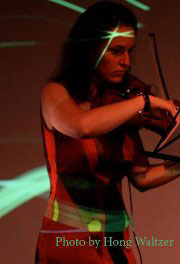Miolina and Zentripetal, Women On Wire
Join us for a debut concert of a vibrant new violin duo, MIOLINA, and an established Violin/Cello duo, Zentripetal. Lynn Bechtold, Mioi Takeda and Jennifer DeVore and guests, will be performing premieres by Lynn, and Martin Phelps, plus including works by Milica Paranosic, Berio, Prokofiev, Schnittke, & Takemitsu.

Imaginary Canvas, a largescale work with instrumentalists and dancers, this performance art piece allows the performers to be part of a ‘living’ canvas, interpreting video instructions ‘in the moment.’ Miolina is a violin duo, including Juilliard alum Mioi Takeda, and Lynn Bechtold. There will be one one-hour group rehearsal on either Fri 9/21 or Sat 9/22. If interested, please email violynn@yahoo.com.
Notes on Imaginary Canvas from composer Martin Phelps:
Imaginary Canvas is an instruction piece (a series of thoughts) for any number of performers. It is at first inspired by a deep interest in the canvas and what can be considered a canvas – the place where mind meets matter – today. I came to the decision that the canvas in this piece would be three-dimensional in the sense that both the performance space and everything and everyone in it (objects, instruments, performers) would make up its fabric, with the performers penetrating it, as an artist would, from different parts of the space. I then became interested in two ideas on which the piece would become centered.
The first one came from Anais Nin:
“We don’t see things as they are, we see them as we are.”
And the second from Henry David Thoreau:
“The world is but a canvas to our imagination.”
In Imaginary Canvas, the canvas is the room, its contents, the people and the instruments. The performers penetrate this canvas with both sound and visual gestures creating a relief, a painting, a sound painting. It is rarely considered, but when a painter works on a canvas he or she also makes sound.The performers will be spread out in the room and will react on an equal level to the instructions. That is to say, there is no difference between visual performance (movements or gestures) and sound performance. They are part of the same “painting”.
The instructions will be projected into the space for both the performers and the public to see. It is very important that the public see the instructions so that they can see the sound painting come to life, and so that they clearly hear and see the varying interpretations of each instruction. Therefore it can allow the spectator to hear and see both the differing levels of imagination used by each performer and the individual realities of each performer when confronted by the same instruction. Thus when the different perspectives come together, a multi-layered sound painting emerges. It also shows that right down to very basic instructions we are all different, we all react differently, interpret things differently, see things differently. Each performer will naturally use a different level of imagination for each instruction, giving it a particular colour, therefore the ensemble as a whole will create a multitude of colours. It is rather like a three dimensional sound painting of modern life, we have one situation, one thought (or instruction) and we all view it in a slightly different way, making life extremely colourful and sometimes kaleidoscopic!
The piece shows that we make our own realities and this is the visual sound of that. A sound painting of the imagination. With the visualization of basic instructions we see and hear the functioning of the imagination more clearly.
This piece will perhaps be the first part of a large scale canvas.
Martin Phelps Bio
Born in England in 1969 (and very happy to have just caught a glimpse of the 60s!) Martin Phelps studied composition at Sussex University with Jonathan Harvey, Michael Finnissy and Martin Butler. In 1997 he moved to Paris to study Computer music at the Centre for Musical Creation Iannis Xenakis (CCMIX), formerly Les Ateliers UPIC. There he met Xenakis and started composition classes with Gerard Pape. During this period he began to develop an interest in three areas: Space, the visual arts (focusing on movement and gesture and their cross over into music) and sound based composition. These three elements continue to be the driving force in his work today.
In 2007 Martin obtained a Masters degree in Creative Music Technology where he specialized in Visual music. The following year he returned to Paris to join The Circle for the Liberation of Sound and Image (CLSI), a laptop ensemble made up of ten composer-performers. It was founded by Gerard Pape and is currently directed by Paul Mefano. Following a recent residency at The GRM, Radio France, the ensemble gave the world premieres of electronic versions of the Stockhausen pieces Prozession and Kurzwellen.
Martin Phelps currently lives in Paris where his time is divided between Music and teaching English at the Sorbonne. His works have been performed in England and France and broadcast on radio.
More about Zentripetal Duo:
More about Lynn of MIOLINA duo

